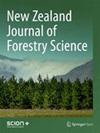Predicting resin pockets and blemishes in radiata pine lumber from log properties
IF 1.1
4区 农林科学
Q2 FORESTRY
引用次数: 0
Abstract
Background: Resin pockets and blemishes in pruned logs of radiata pine (Pinus radiata D.Don) can reduce the value of clear and moulding grades of lumber. External resin features (ERF) on the bark of the logs have proved an effective method of predicting the incidence of resin pockets in the lumber. Resin canals have been associated with resin blemishes in radiata pine, and could prove useful in improving the prediction of the grade recovery of lumber. Methods: Pruned butt logs of radiata pine trees from two forests in the North Island, New Zealand, were selected for low, moderate, and severe levels of external resin features (ERF) on the bark, and for low, average, and high resin canal diameter, frequency and brightness from breast height increment cores. The relationships were evaluated between these properties, and the lumber resin features and grade recovery of the logs. Results: The number of resin pockets, the blemish rating, and the percentage of boards with resin streaks and resinous heartwood increased, and the recovery of clears and moulding grade boards and the lumber value declined, with the severity of the ERF class of the logs. Multiple regression models gave good predictions of the grade recovery and loss of lumber value, using the log ERF class, volume, heartwood content, and number of Type 1 resin pockets on the ends of the logs, as independent variables. The resin canal properties did not improve the regression models. Resin blemishes were associated with Type 2 resin pockets, and were more frequent in the forest where false growth rings were present. This suggests the constitutive resin flow from resin canals, rather than the resin canal size and frequency, is more important in determining the incidence of resin blemishes. Conclusions: The prediction of the grade recovery of lumber using the ERFs of radiata pine logs, was supplemented by the log volume, heartwood content and number of Type 1 resin pockets on the ends of the logs. The environmental factors that drive the constitutive resin enrichment of resin canals, such as drought conditions that give rise to false growth rings, could be useful in improving the prediction of grade recovery for forest stands.从原木性质预测辐射松木材中的树脂袋和瑕疵
背景:辐射松(Pinus radiata D.Don)修剪原木中的树脂袋和瑕疵会降低木材的透明度和成型度。原木树皮上的外部树脂特征(ERF)已被证明是预测木材中树脂袋发生率的有效方法。树脂管与辐射松中的树脂瑕疵有关,可能有助于提高木材等级回收率的预测。方法:选择新西兰北岛两个森林的辐射松修剪后的树干,对其树皮外部树脂特征(ERF)的低、中、重度进行筛选,并从乳腺高度增量岩芯中对树脂管直径、频率和亮度的低、平均和高进行筛选。评估了这些性能与木材树脂特性和原木品位回收率之间的关系。结果:随着原木ERF等级的严重程度,树脂袋的数量、缺陷等级、有树脂条纹的板材和树脂心材的百分比增加,而透明和模塑级板材的回收率和木材价值下降。多元回归模型使用原木ERF等级、体积、心材含量和原木末端1型树脂袋的数量作为自变量,对木材的品位回收率和损失值进行了很好的预测。树脂管的性质并没有改善回归模型。树脂瑕疵与2型树脂袋有关,在存在假生长环的森林中更为常见。这表明,在确定树脂瑕疵的发生率时,来自树脂管的组成树脂流,而不是树脂管的大小和频率更重要。结论:利用辐射松原木的ERF预测木材的等级回收率,并辅以原木体积、心材含量和原木末端1型树脂袋的数量。驱动树脂通道组成型树脂富集的环境因素,如导致假生长环的干旱条件,可能有助于改进林分等级恢复的预测。
本文章由计算机程序翻译,如有差异,请以英文原文为准。
求助全文
约1分钟内获得全文
求助全文
来源期刊

New Zealand Journal of Forestry Science
FORESTRY-
CiteScore
2.20
自引率
13.30%
发文量
20
审稿时长
39 weeks
期刊介绍:
The New Zealand Journal of Forestry Science is an international journal covering the breadth of forestry science. Planted forests are a particular focus but manuscripts on a wide range of forestry topics will also be considered. The journal''s scope covers forestry species, which are those capable of reaching at least five metres in height at maturity in the place they are located, but not grown or managed primarily for fruit or nut production.
 求助内容:
求助内容: 应助结果提醒方式:
应助结果提醒方式:


